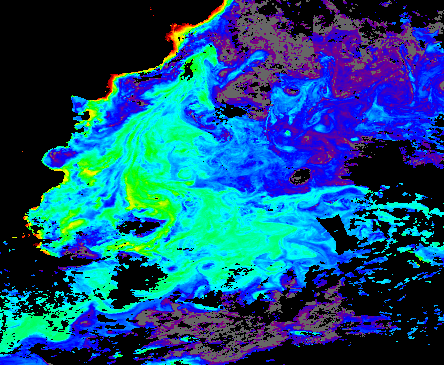Project: Coccolithophores of the Patagonian Shelf 2008
Description
A main focus of the COPAS project is to study coccolithophores at the fringes of the Southern Ocean on the Patagonian Shelf (PS) east of Argentina. Some of the most extensive coccolithophore blooms in the world occur on the PS but the remoteness of the region has impeded their study. In this part of the southern ocean, the most basic knowledge is lacking about a) the relationships between coccolithophores and other species of phytoplankton, b) the impact of coccolithophores on the carbon cycle and c) how environmental changes affect bloom taxonomy and function.
This will be the first multi-disciplinary ship-based investigation of these mesoscale blooms, building on an understanding of coccolithophore ecology derived almost exclusively from northern hemisphere bloom studies. This study will document the ecological factors regulating the spatial-temporal distribution of the coccolithophore blooms (the largest recurring coccolithophorid bloom in the sounthern hemisphere) using a combination of underway, satellite and discrete sampling. Satellite measurements will provide quantitative estimates of particulate inorganic carbon (PIC) and particulate organic carbon (POC) in coccolithophore blooms while underway hydrographic and optical sampling will allow real-time evaluation of coccolithophores in both bloom and surrounding non-bloom waters. Vertical casts across the shelf front will provide depth resolved coccolithophore abundance as well as estimates of phytoplankton species richness.
Another goal is to examine the effects of ocean acidification on algal optical properties, coccolithophore concentrations and PIC concentrations (to be determined from deck experiments). Dilution experiments will provide key estimates on phytoplankton growth rates, coccolithophore growth rates and calcification rates, plus the intrinsic loss rates (i.e. phytoplankton grazing, coccolithophore grazing and dissolution associated with zooplankton grazing). PIC has not been examined in dilution experiments heretofore. The project will yield fundamental insights into a) our understanding of coccolithophore ecology (not just Emiliania huxleyi) and b) the utility of the "functional group" concept to describe coccolithophore variability over the PS. Such knowledge is critical to model complex biogeochemical processes that regulate phytoplankton production and the biological pump. It is also worthy of note that the PS coccolithophore populations are at the western edge of a southern hemisphere belt of enhanced coccolithophores thought to extend from the southern tip of South America to waters south of Australia, (~180 degrees of longitude).
The burning of fossil fuels is predicted to increase atmospheric CO2 to 750 p.p.m.v. or more under various future scenarios. As a large fraction of the anthropogenic CO2 diffuses into seawater, the ocean is becoming more acidic; it is predicted that the pH of the surface ocean will drop by up to 0.7 units by year 2300, a 5-fold increase in the proton concentration. A major goal is to examine the effects of ocean acidification on coccolithophores, in a region of low calcite saturation. This study will provide the first detailed analysis of the coccolithophores in this enormous area of high suspended calcite water. The results will be highly relevant to our basic understanding of the marine carbon cycle.
Financial support for the participating UK scientists was also provided by the Luminescence and Marine Plankton project funded by the Defence Science and Technology Laboratory under the Joint Grant Scheme programme via Proposal Ref. 1166 to Dr. John Allen.

People
Lead Principal Investigator: William M. Balch
Bigelow Laboratory for Ocean Sciences
Co-Principal Investigator: Dr John T Allen
National Oceanography Centre (NOC-OBE)
Project Coordinator: Mr Bruce Bowler
Bigelow Laboratory for Ocean Sciences
Contact: William M. Balch
Bigelow Laboratory for Ocean Sciences
BCO-DMO Data Manager: Stephen R. Gegg
Woods Hole Oceanographic Institution (WHOI BCO-DMO)
Programs
Ocean Carbon and Biogeochemistry [OCB]
